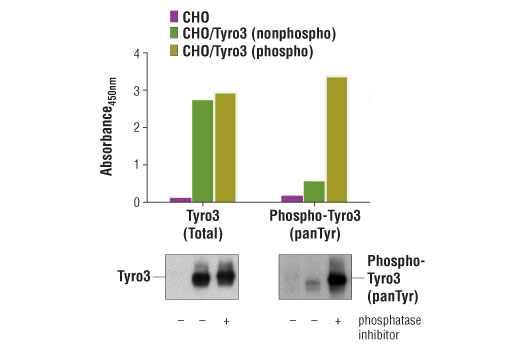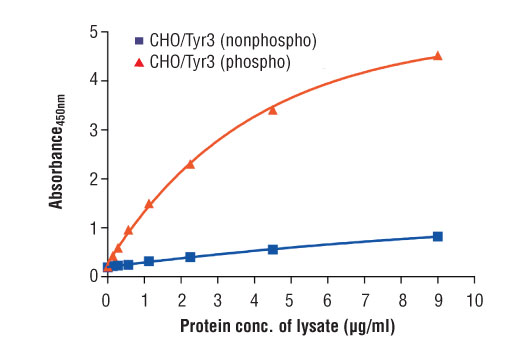| Product Includes | Product # | Quantity | Color | Storage Temp |
|---|---|---|---|---|
| Tyro3 Rabbit mAb Coated Microwells | 69568 | 96 tests |
|
+4C |
| Phospho Tyrosine Mouse Detection mAb | 12982 | 1 ea |
|
+4C |
| Anti-mouse IgG, HRP-linked Antibody (ELISA Formulated) | 13304 | 1 ea |
|
+4C |
| Detection Antibody Diluent | 13339 | 11 ml |
|
+4C |
| HRP Diluent | 13515 | 11 ml |
|
+4C |
| TMB Substrate | 7004 | 11 ml |
|
+4C |
| STOP Solution | 7002 | 11 ml |
|
+4C |
| Sealing Tape | 54503 | 2 ea |
|
+4C |
| ELISA Wash Buffer (20X) | 9801 | 25 ml |
|
+4C |
| ELISA Sample Diluent | 11083 | 25 ml |
|
+4C |
| Cell Lysis Buffer (10X) | 9803 | 15 ml |
|
-20C |
*The microwell plate is supplied as 12 8-well modules - Each module is designed to break apart for 8 tests.
Description
PathScan® Phospho-Tyro3 (panTyr) Sandwich ELISA Kit is a solid phase sandwich enzyme-linked immunosorbent assay (ELISA) that detects endogenous levels of tyrosine-phosphorylated Mer protein. A Tyro3 Rabbit mAb has been coated onto the microwells. After incubation with cell lysates, Tyro3 protein (phospho and nonphospho) is captured by the coated antibody. Following extensive washing, a Phospho-Tyrosine Mouse Detection mAb is added to detect the captured phospho-Tyro3 proteins. Anti-mouse IgG, HRP-linked antibody is then used to recognize the bound detection antibody. HRP substrate, TMB, is added to develop color. The magnitude of optical density for this developed color is proportional to the quantity of Tyro3 protein phosphorylated on tyrosine residues.
*Antibodies in this kit are custom formulations specific to kit.
Specificity/Sensitivity
Background
Tyro3 is a receptor tyrosine kinase belonging to the TAM subfamily (Tyro3, Axl and Mer). All three members have similar domain structure composed of an extracellular region with 2 Ig-like domains, followed by 2 FNII-like domains, a single transmembrane region, and a cytoplasmic tyrosine kinase domain (1). The natural ligand for Tyro3, as well as Axl and Mer, is Gas6 (growth arrest-specific gene 6) (1,2). Expression pattern and target knockout data indicate an important role of Tyro3 in apoptotic cell phagocytosis of dendritic cells and macrophages (3), NK cell differentiation (4), reproductive neuron survival and migration (5), osteoclast stimulation (6,7), as well as cortical and hippocampal neuron function (8). Both MAPK and PI3K pathways have been suggested as downstream targets of Tyro3 activation (7,8). Tyro3 has also been shown to be correlated to melanoma tumorigenesis, likely through its reglulatory role in the expression of oncogenic microphthalmia-associated transcription factor (MITF) (9).
- Binder, M.D. and Kilpatrick, T.J. (2009) Neurosignals 17, 277-87.
- Nagata, K. et al. (1996) J Biol Chem 271, 30022-7.
- Seitz, H.M. et al. (2007) J Immunol 178, 5635-42.
- Caraux, A. et al. (2006) Nat Immunol 7, 747-54.
- Pierce, A. et al. (2008) Mol Endocrinol 22, 2481-95.
- Nakamura, Y.S. et al. (1998) Stem Cells 16, 229-38.
- Katagiri, M. et al. (2001) J Biol Chem 276, 7376-82.
- Prieto, A.L. et al. (2007) Neuroscience 150, 319-34.
- Zhu, S. et al. (2009) Proc Natl Acad Sci U S A 106, 17025-30.
Background References
Cross-Reactivity Key
H: human M: mouse R: rat Hm: hamster Mk: monkey Vir: virus Mi: mink C: chicken Dm: D. melanogaster X: Xenopus Z: zebrafish B: bovine Dg: dog Pg: pig Sc: S. cerevisiae Ce: C. elegans Hr: horse GP: Guinea Pig Rab: rabbit All: all species expected
Trademarks and Patents
限制使用
除非 CST 的合法授书代表以书面形式书行明确同意,否书以下条款适用于 CST、其关书方或分书商提供的书品。 任何书充本条款或与本条款不同的客书条款和条件,除非书 CST 的合法授书代表以书面形式书独接受, 否书均被拒书,并且无效。
专品专有“专供研究使用”的专专或专似的专专声明, 且未专得美国食品和专品管理局或其他外国或国内专管机专专专任何用途的批准、准专或专可。客专不得将任何专品用于任何专断或治专目的, 或以任何不符合专专声明的方式使用专品。CST 专售或专可的专品提供专作专最专用专的客专,且专用于研专用途。将专品用于专断、专防或治专目的, 或专专售(专独或作专专成)或其他商专目的而专专专品,均需要 CST 的专独专可。客专:(a) 不得专独或与其他材料专合向任何第三方出售、专可、 出借、捐专或以其他方式专专或提供任何专品,或使用专品制造任何商专专品,(b) 不得复制、修改、逆向工程、反专专、 反专专专品或以其他方式专专专专专品的基专专专或技专,或使用专品开专任何与 CST 的专品或服专专争的专品或服专, (c) 不得更改或专除专品上的任何商专、商品名称、徽专、专利或版专声明或专专,(d) 只能根据 CST 的专品专售条款和任何适用文档使用专品, (e) 专遵守客专与专品一起使用的任何第三方专品或服专的任何专可、服专条款或专似专专

